
hotline:
17715390137
Tel/Wechat:
18101240246 (Technology)
0512-68565571
Email:mxenes@163.com (Sales Engineer)bkxc.bonnie@gmail.com
Scan the code to follow or search the official account on WeChat:
2D Materials Fronrier After paying attention,
click on the lower right corner to contact us,
Enter enterprise WeChat.
Professional Services Online

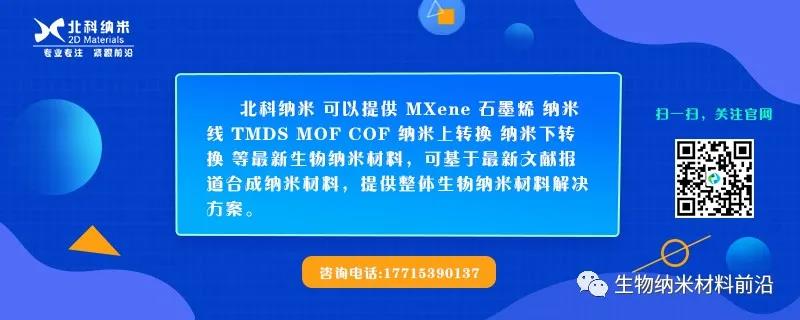
Recent studies have found that gold nanoparticles exhibit excellent mimic enzyme activity, similar to peroxidase, oxidase, catalase, superoxide dismutase or reductase. Compared with biological enzymes, this enzyme has the advantages of easy synthesis, good tunability, good biocompatibility, low cost, etc., and has good application prospects in biomedicine or biochemical analysis.
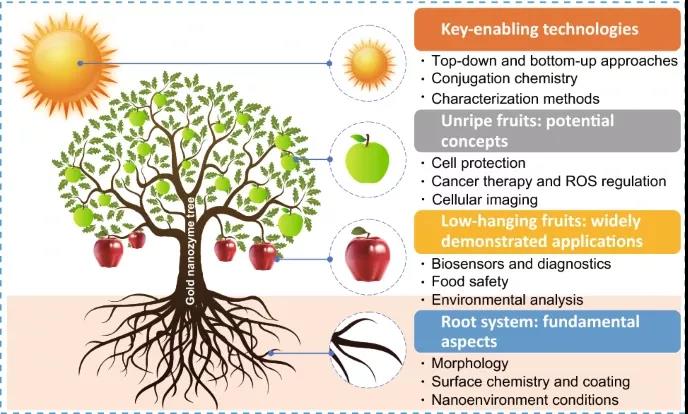
Highlights of this article
1. The ability of gold nanomaterials to simulate enzyme activity provides a new way for diagnosis and treatment in the field of biomedicine.
2. Controlling the physical and chemical properties (size, morphology and surface chemistry) of nanomaterials is still the first obstacle to practical applications.
3. At present, a large number of in vitro applications in the diagnostic field have become a reality, while in vivo applications such as tumor treatment or intracellular ROS level control require further control of side effects.
Introduction
In this article, Cuong Cao and others from Queens University of Belfast systematically reviewed more than 200 research progress on the basic principles and potential applications of gold nanozymes. The review shows that the morphology and surface chemistry of nanoparticles play an important role in their catalytic performance and external parameters such as pH and temperature. However, practical applications often require specific biometric identification elements to be immobilized on nanoenzymes, which will have unexpected positive or negative effects on its activity. Therefore, the rational design of highly efficient nanoenzymes is still a crucial challenge. Different approaches have been explored, including applying peroxidase-like nanoenzymes to clinical diagnosis or regulating intracellular oxidative stress through its catalase and superoxide dismutase activities. The review also shows that it is necessary to understand how external parameters promote or inhibit each of these activities, because more than one of them may coexist. Similarly, further toxicity studies are needed to ensure the applicability of gold nanozymes in vivo. The research status and development prospects of gold nanozymes are reviewed, and the significance of gold nanozymes in biomedical fields such as food safety, environmental analysis and chemical engineering is pointed out.
Graphic guide
I Introduction to AuNPsThe optical, electrical, magnetic, catalytic, supramolecular, biological toxicity and bioconjugation, and localized surface plasmon resonance (LSPR) properties of gold nanoparticles (AuNPs) depend on the size, shape and surface chemistry of the gold nanoparticles. Therefore, controlling these parameters is essential for the development of AuNP-based chemical and biosensors. There are two methods for the synthesis and preparation of gold nanostructures: bottom-up and top-down. The former involves techniques such as chemical synthesis, self-assembly or molecular manufacturing. These techniques involve the nucleation of gold atoms and their growth from molecular precursors into colloidal gold nanoparticles. The latter refers to methods such as photolithography, pyrolysis, and grinding. Currently, the bottom-up approach has been widely explored to produce AUNPs of various sizes and shapes, such as spheres, rods, cubes, prisms, stars, cages, polygons, and many other shapes.
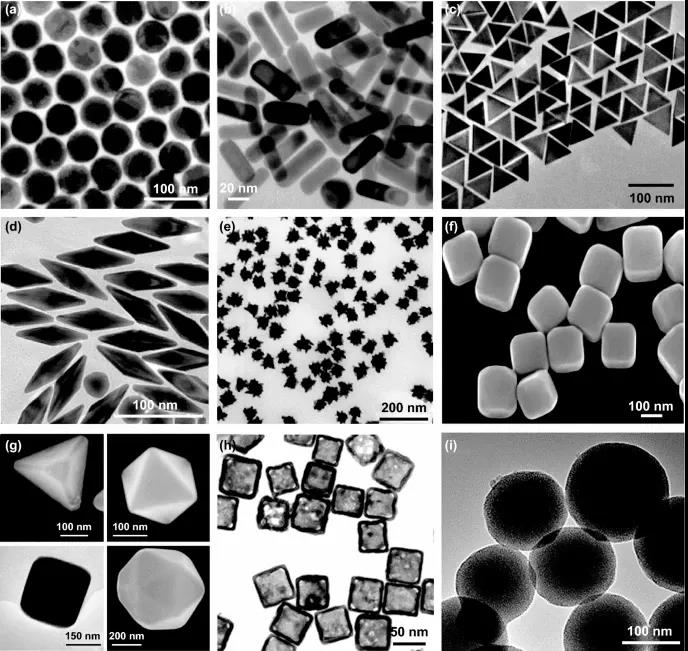
Figure 1. The bottom-up method is used to synthesize AuNPs with different shapes. (a) sphere, (b) rod, (c) prism, (d) double cone, (e) star, (f) cube, (g) polygonal nanocrystal, (h) cage, (i) gold@dioxide Silicon hybrid nanoparticles.
II Catalytic properties of gold nanoparticles
Gold nanoparticles have a variety of catalytic activities, such as oxidase, glucose oxidase, peroxidase, catalase, superoxide dismutase SOD and reductase catalytic activity. These discoveries led to the emergence of the term nanozyme. The size, morphology, surface chemistry or surface functional layer of the nanoparticles will strongly affect the catalytic activity, and some external parameters such as the pH or temperature of the surrounding medium will also affect the catalytic activity of the gold nanoparticles.
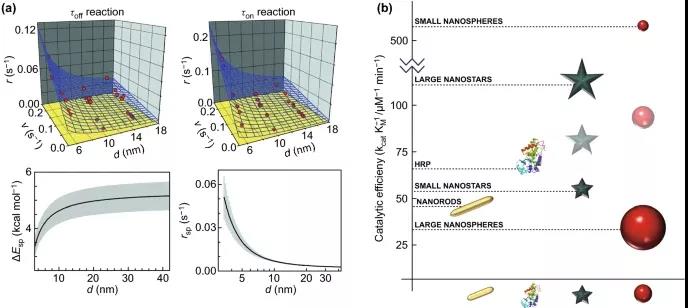
Figure 2. Comparison of the catalytic efficiency of AuNPs with different particle sizes and shapes. (a) Kinetic study on the reduction of resazurin to resorufin catalyzed by AuNPs of different particle sizes. It shows how the size of NP affects the relationship between the rate of surface remodeling and the conversion rate of catalytic product formation (top left) and product dissociation (top right), as well as the relationship between NP size and activation energy (bottom left) and spontaneous dynamic surface remodeling rate (bottom right) (B) Compare the catalytic efficiency of different shapes and sizes of AuNP on peroxidase-like activity. HRP, their biological counterparts, are also included in the chart.
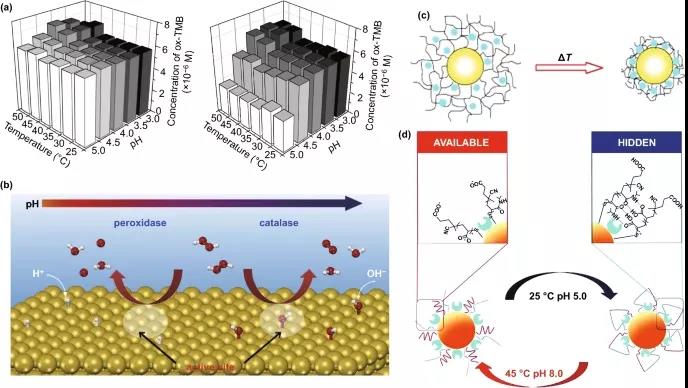
Figure 3. The dependence of the different catalytic activities of AuNPs on pH and temperature. (a) AUNPs coated with different concentrations of the same peptide (3 times higher on the left) respond differently to temperature and pH changes because they have a peroxidase-like oxidation of 3,3 ,5,5 -tetramethyl The ability of benzidine (TMB), (b) gold nanoparticles adsorb on the gold surface under alkaline conditions, showing different H₂O₂ decomposition pathways, (c) the thermosensitive polymer layer used to stabilize AuNPs may undergo structural changes, thereby To prevent the catalytic activity state of nanomaterials, (d) on/off nanoenzymes are controlled by temperature and pH changes, thereby forming a cage structure through hydrogen bonds between polymer chains on the AuNP surface.
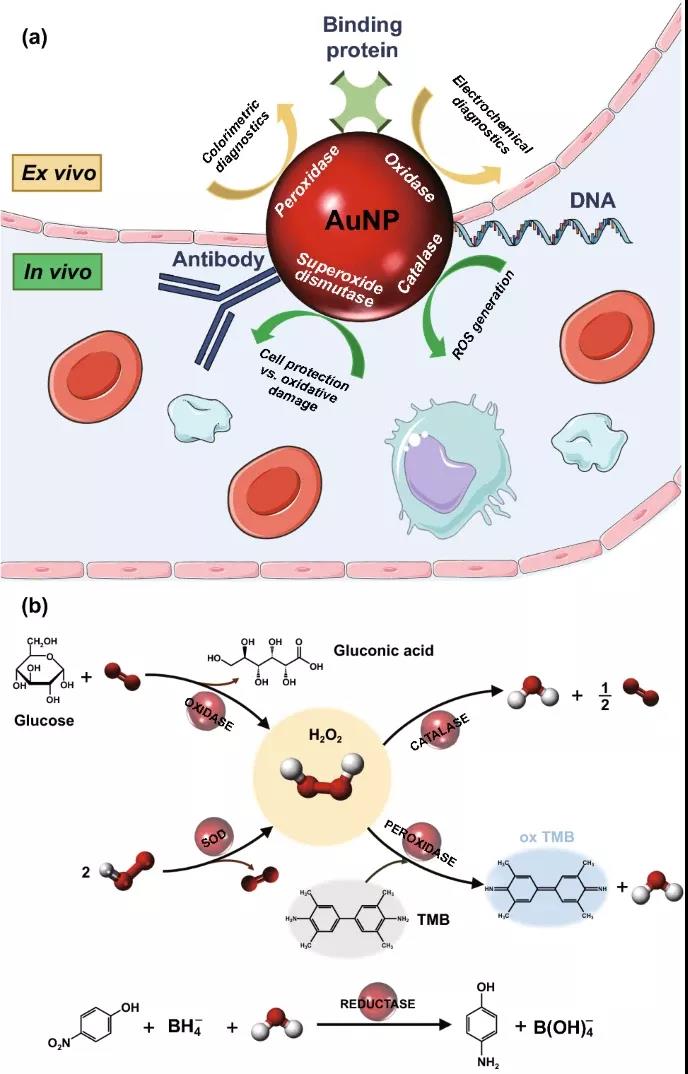
Figure 4. (a) Summarizes the different catalytic activities of AuNPs mainly used in the biomedical field. (b) Use a representative example to describe these activities.
III Biomedical applications of gold nanozymes
Gold nanomaterials have been proven to have a wide range of applications in the field of biomedicine, such as photothermal therapy, drug delivery vehicles, cell or in vivo imaging. The most successful application in biomedicine is to use AuNPs as visible light indicators for lateral flow analysis, which is the basic technology for pregnancy tests. With the discovery of many nanoenzyme properties, it has led to a wide range of biomedical applications that have not been explored so far.
3.1 The development of biosensing and biosensors: clinical diagnostics
The peroxidase mimic activity of AuNPs allows it to be used as a signal sensor capable of generating chrominance signals. At present, gold nanomaterials are mainly used to oxidize 3,3,5,5-tetramethylbenzidine TMB, a substrate catalyzed by horseradish peroxidase HRP, widely used in immunoassays. Due to the ease of surface modification with specific ligands, gold nanomaterials can be used to develop diagnostic tools for different targets, such as viruses, exons, red blood cells, amino acids and even ions. In addition to colored products, gold nanozymes can also catalyze the conversion of different substrates into fluorescent, luminescent or Raman active products; some systems use the electrons generated in the reaction to develop electrochemical sensors.
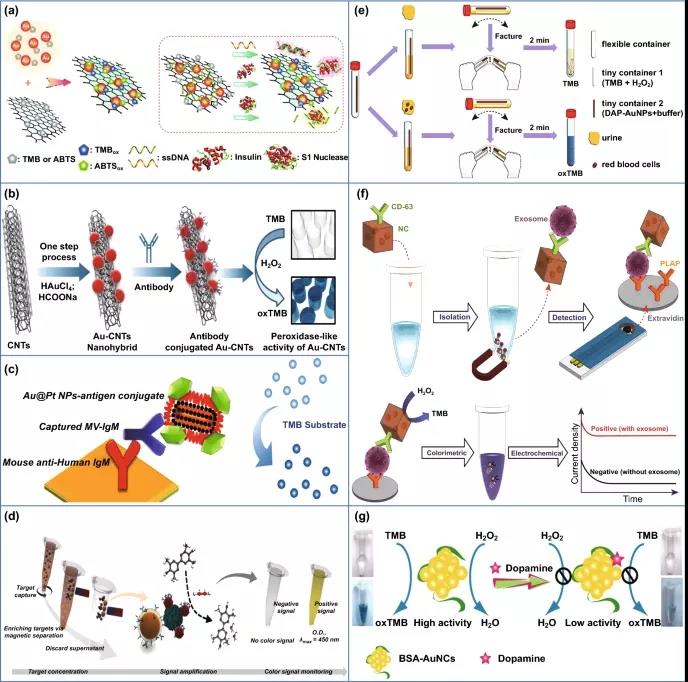
Figure 5. Peroxidase-like activity of AuNPs used as clinical diagnostic tools. (a) AuNP grown on graphene sheets is used to develop an on-off chromaticity sensor. (b) Nano-gold/carbon nanotube hybrid technology is used for colorimetric detection of influenza virus. (c) Rod-shaped gold-platinum core/shell nanoparticles for measles virus detection. (d) The combined use of nanomagnetic microspheres and gold nanoparticles to separate and detect influenza viruses. (e) User-friendly urine hemoglobin and red blood cell testing equipment. (f) Gold-loaded nanoporous iron oxide nanoparticles are used for direct exobody detection.
3.2 ROS generation
AuNP can penetrate cells and cell compartments and cause cytotoxicity (necrosis) through oxidative stress. Therefore, nanozymes with mimetic peroxidase activity can catalyze the decomposition of hydrogen peroxide and generate reactive oxygen species. Induced toxicity is mainly used for tumor treatment, and its catalytic performance is enhanced by photodynamic therapy (PDT).
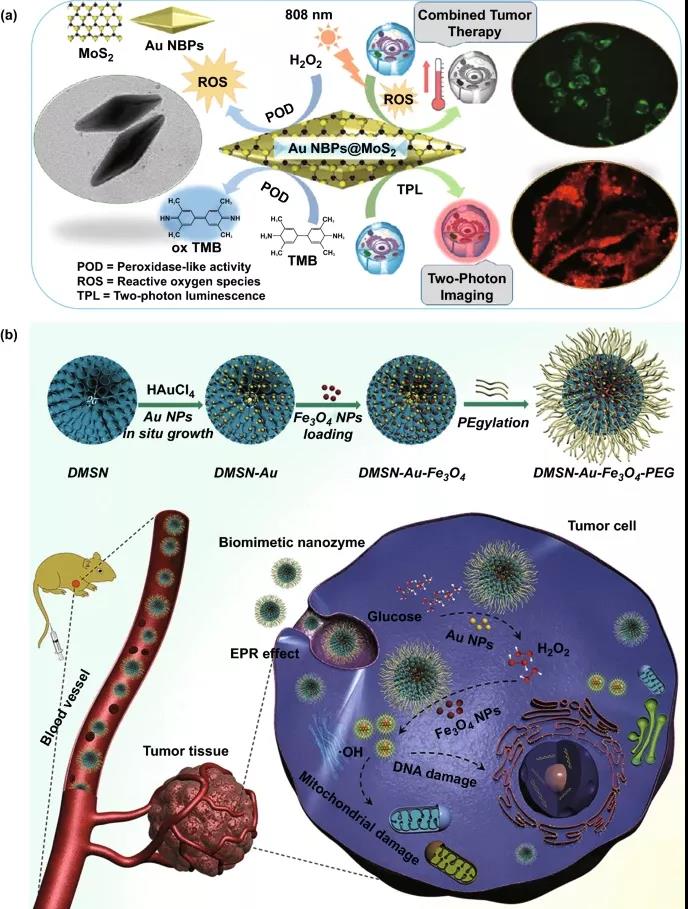
Figure 6. Gold nanozymes used in tumor treatment. (a) Peroxidase-like activity is combined with photodynamic and photothermal therapy for tumor imaging and local treatment. (b) After guiding NPs to the corresponding tissues, various enzyme activities combine to produce ROS in the cell.
3.3 Cell protection
AuNPs can also be used for the protection of ROS. The nanoenzyme activity of AuNPs can be adjusted according to the surface chemistry of the nanoparticles or the microenvironment.
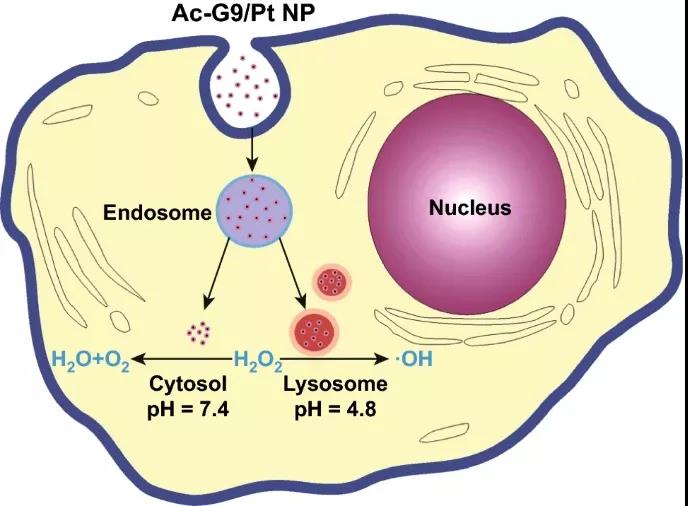
Figure 7. The pH dependence of the catalytic performance of gold nanozymes shows that H₂O₂ has two decomposition pathways. The acidic medium promotes the decomposition of H₂O₂ into two hydroxyl radicals (peroxidase-like activity), while the neutral pH medium decomposes it into H₂O and O₂ (catalase-like activity).

Figure 8. Gold nanozymes are used as active oxygen scavengers for cell protection. (a) The catalase-like activity of AUNC embedded in amine-terminated dendrimers is used to protect neurons from oxidative damage. (b) Light-mediated reversible regulation of ROS levels by AuNPs-carrying mesoporous NPs.
IV Other applications of gold nanozymes
The catalytic properties of AuNPs can be applied to different biological processes with industrial or scientific significance, such as oxidizing amino acids, cutting RNA, inducing Fenton reactions, and even catalyzing enantioselective reactions. In addition to its biological applications, AuNPs can also be widely used in other fields: 1) Environmental applications: Most applications in this category are related to diagnostic tools for detecting toxic pollutants in environmental water; 2) Food safety: food There are many types of pollutants, including microorganisms, pesticides, antibiotics or toxins. Some sensors based on gold nanozymes have been developed for microbial pollutants; 3) Other applications: In addition to diagnosis and treatment, gold nanoparticles also play an important role in establishing artificial biochemical models or implementing chemical catalysis.
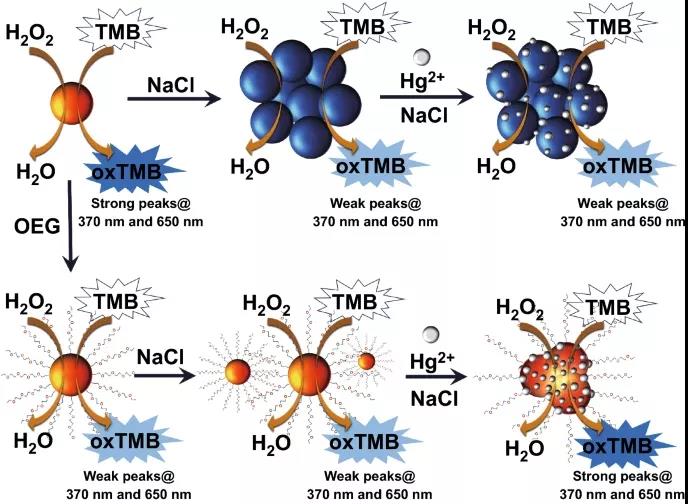
Figure 9. The gold nanoenzyme colorimetric sensor detects Hg2+ ions in seawater.
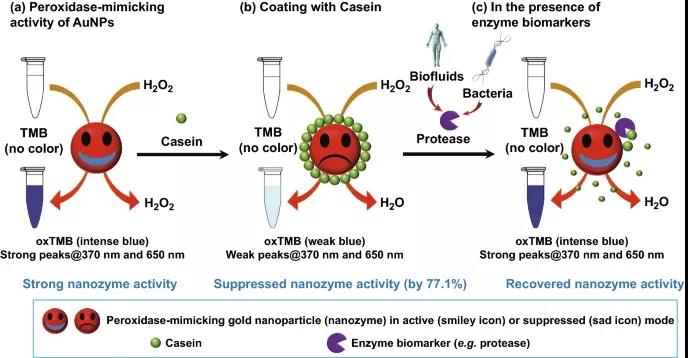
Figure 10. Colorimetric sensors using gold nanozymes to detect proteolytic biomarkers of food spoilage or human diseases.
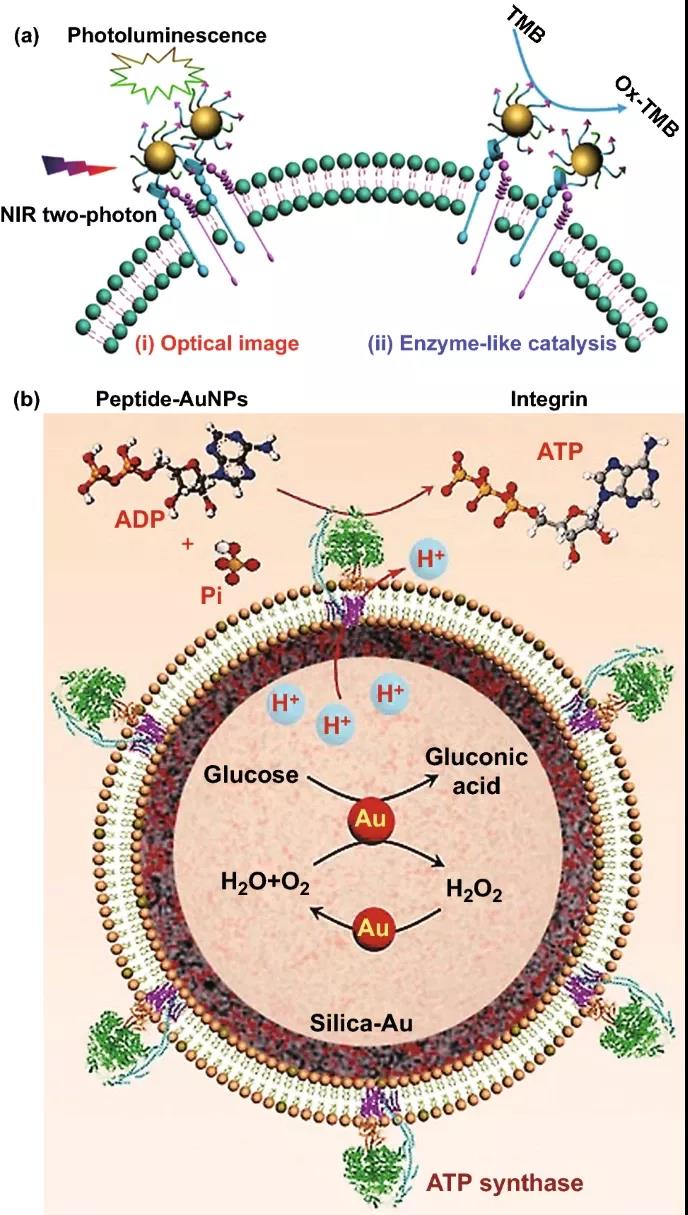
Figure 11. Cell membrane engineering applications are used to (a) diagnose health conditions or (b) simulate the biological mechanism of ATP production in artificial compounds.
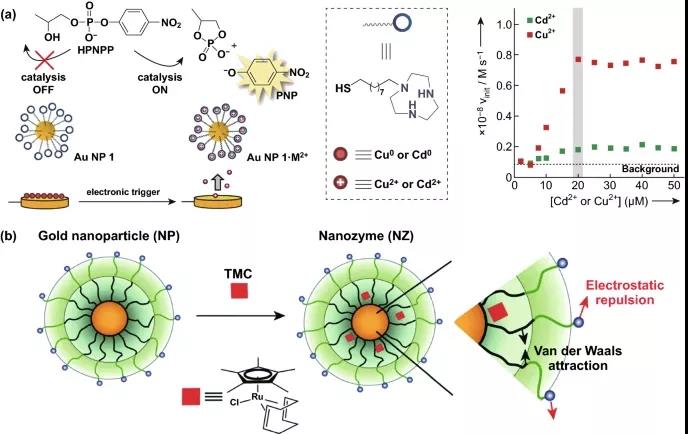
Figure 12. The traditional definition of nanoenzymes combines gold nanoparticles and metal ions as catalysts. (a) The catalytic cracking of HPNP by AuNP combined with monomolecular membrane complexing Cd2⁺ and Cu2⁺ ions. (b) Ru catalyst is embedded in the AuNPs protective layer.
Written by: Nawei Express Editorial Department
Editor: Nawei Express Editorial Department

| Reminder: Beijing Beike New Material Technology Co., Ltd. supplies products only for scientific research, not for humans |
| All rights reserved © 2019 beijing beike new material Technology Co., Ltd 京ICP备16054715-2号 |